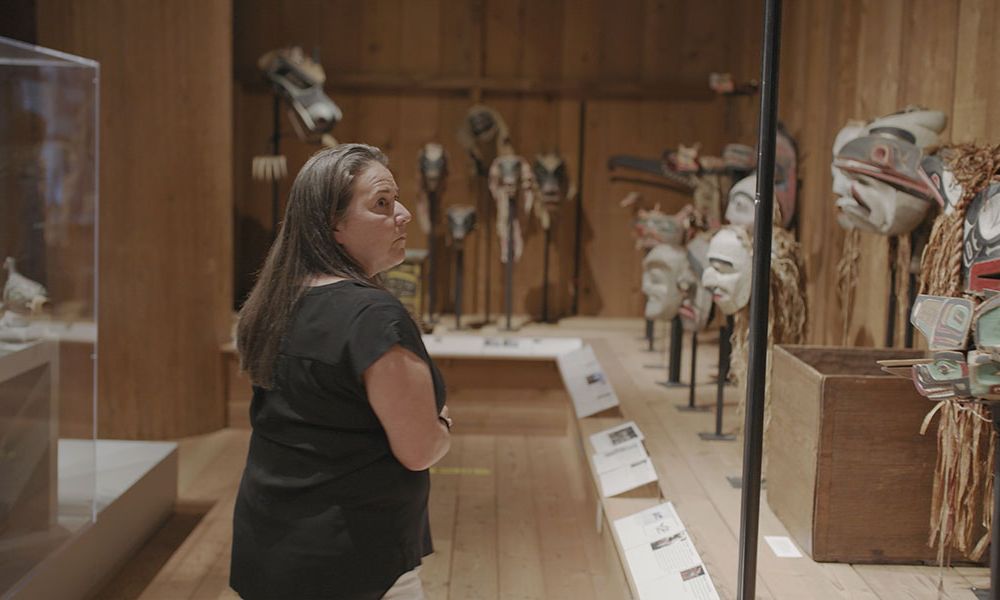A scene from So Surreal: Behind the Masks (2024), a documentary by Neil Diamond and Joanne Robertson Courtesy Rezolution Pictures and the Toronto International Film Festival
“Repatriation is a complex beast,” the Cree Canadian film-maker Neil Diamond muses, in his own voiceover, in his documentary So Surreal: Behind the Masks (co-directed by Joanne Robertson). A production of the Canadia Broadcasting Corporation and National Film Board of Canada’s The Documentary Channel that has just premiered at the Toronto International Film Festival (Tiff), So Surreal takes an accessible, affable approach in localising an issue of fraught global import.(It is not the only repatriation documentary at Tiff this year: Mati Diop’s more formally and politically rigorous Dahomey continues its rollout here.) In tracing the lineage of several Indigenous ceremonial masks at one time owned by artists and critics associated with the Surrealists, Diamond’s film is resolutely banal but tells a compelling story about the chains of ownership by which objects of enduring cultural importance to Indigenous people are laundered into Western collections and museums.
The story begins with Diamond in New York City, where, he says, he just happened to read in the newspaper about a Yup’ik mask being sold alongside 20th century masterpieces at the Tefaf New York fair. Diamond makes himself a character in the film throughout, an audience surrogate always on hand to ask aw-shucks questions.
A scene from So Surreal: Behind the Masks (2024), a documentary by Neil Diamond and Joanne Robertson Courtesy Rezolution Pictures and the Toronto International Film Festival
His curiosity piqued, Diamond travels to Alaska, where he learns from Yup’ik elders about the use of masks in prayer rituals; and to the northwest of Canada, to the lands of the Kwakwa̱ka̱ʼwakw. As part of Canada’s effort to suppress tribal traditions and force assimilation, ritual objects such as masks, important for practices such as potlatch ceremonies, were seized by government agents and often sold off to collectors such as George Heye, whose collection seeded the Smithsonian’s National Museum of the American Indian. As the film notes, ceremonial masks were often designed as complementary pairs, a fact of which Heye and other amassers of Indigenous objects were ignorant—they thought they had duplicates and would often display one mask and stash away or sell off its companion. Among the individual objects the film attempts to track down is the matching pair of a mask that hangs in the Musée du Louvre.
The film is most successful in its attention to individual objects. Many Indigenous masks were kept in storage by Heye and sold off to raise funds via the Third Avenue gallery of dealer Julius Carlebach, a “speciali[st] in primitive and ancient art” per his New York Times obituary, and a particular favourite of the Surrealists in exile during the Second World War. As Constantin Brâncuși responded to the sleek planar faces of African carvings, so the Surrealists drew inspiration from the lysergic animal symbolism of objects such as a Kwakwa̱ka̱ʼwakw raven transformation mask designed to open during a dance.
A scene from So Surreal: Behind the Masks (2024), a documentary by Neil Diamond and Joanne Robertson Courtesy Rezolution Pictures and the Toronto International Film Festival
Back in France, Diamond sees the objects in private collections and at museums such as the Musée du Quai Branly–Jacques Chirac, whose curators are attempting to open dialogue with Indigenous representatives. Vintage catalogues of museum exhibitions and auctions, along with original photos from colonial administrators, are vital clues for experts hoping to locate looted artifacts, and Diamond meets several of them, including a French anthropologist; the dealer Donald Ellis, who specializes in Indigenous art but also works on repatriation issues with tribal representatives; and a Kwakwa̱ka̱ʼwakw cultural leader who drolly notes how owners of stolen objects seize up at mention of “the R-word: repatriation”. (The struggle of the Kwakwa̱ka̱ʼwakw to reclaim their patrimony was the subject of a previous Canadian documentary, 1984’s Box of Treasures, that is liberally excerpted here.)
Competing claims of ownership and affinity are not easy to untangle—repatriation really is a complex beast!—but the film engages directly with a fairly unambiguous case. Barbara Duthuit, a socialite, trustee of the Baltimore Museum of Art and the widow of the son of the Surrealist critic Georges Duthuit, owns the raven transformation mask that was taken by the Canadian government, bought and admired by her late father-in-law, and is earnestly sought back by Kwakwa̱ka̱ʼwakw people trying to keep their heritage alive. (As is explained, successful repatriations can take the form of a gift, anonymous or with a tribal ceremony honoring the Western donor, a brokered sale to a tribal ally followed by a donation or a long-term loan.) The efforts of Diamond, Ellis and the Kwakwa̱ka̱ʼwakw to reach Duthuit and get a response give the film its most urgent through-line, and prompt viewers accustomed to the Western museum style of canon-building and exhibition to consider what else stewardship might look like.
Watch a trailer for So Surreal: Behind the Masks:

